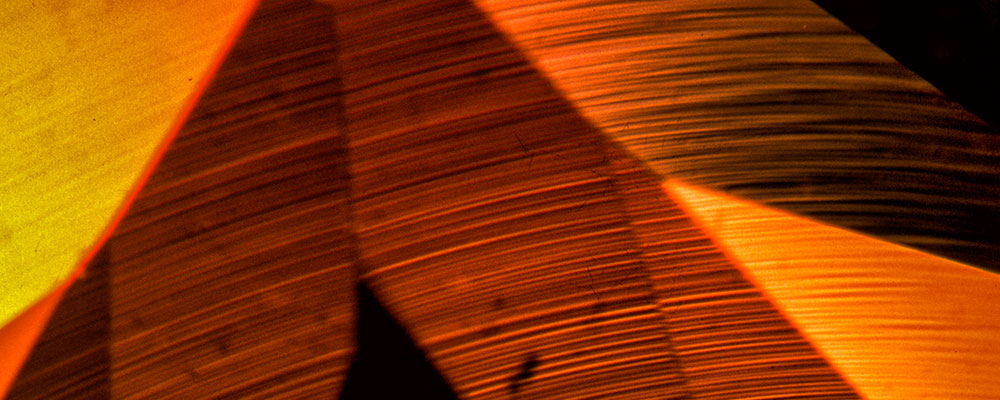Virtually all gemologists are aware of the curved growth lines and gas bubbles in Verneuil (flame-fusion) synthetic corundum, but few understand exactly why they occur and how they are distributed in these stones. This article clarifies these important identifying features.
Verneuil Synthetic Corundum • Dangerous Curves

Figure 1. A selection of half boules grown by the Verneuil process, illustrating many of the colors these crystals are grown in. Due to stress in the growth process, a parting plane forms in all Verneuil grown synthetic corundums. Splitting boules along this plane prior to cutting relieves this stress. Photo © Richard W. Hughes
Curved Growth Lines
Curved growth lines are a prominent feature of virtually all Verneuil synthetic corundums. While many believe they are similar to the growth rings of a tree, the truth is quite different. Trees and natural crystals grow outward in all directions from a central point. In trees, these lines are concentric, while in natural crystals, they are angular, but both form from a central point.
Verneuil synthetic corundum is quite different, growing in a single direction only (up) via feed material dropped from above. Since the growth begins from a tiny molten droplet, the growth lines form in semicircular layers following the top surface of that droplet (see Figure 2). Thus they are not concentric.
These lines are seen by looking at a slightly oblique angle towards the top surface of the boule, as shown in Figure 2. Unlike a tree, if one looks parallel to the length of the boule, no lines will be seen.

Figure 2. Distribution of curved growth lines and gas bubbles in Verneuil synthetic corundum. Curved growth lines are best viewed by looking at an angle slightly oblique to the boule's length. Gas bubbles usually occur in layers that follow the curved growth lines. When the bubbles are elongated, the elongation is usually at right angles to the direction of the curved growth lines, with the head of the bubble facing the top of the boule. This is because bubbles are formed by boiling of the molten top surface of the boule as it grows. Illustration © Richard W. Hughes
Curved growth lines in Verneuil synthetics come in two flavors. Sharp narrow lines termed "striae" are found in synthetic ruby and the vanadium-colored color-change synthetic sapphire. In all other varieties, the curved lines occur in dull-edged bands (best seen by placing a white diffusing filter over the well of the microscope). While one would not expect to find any lines in the synthetic colorless variety, examining the gem's short-wave UV fluorescence will often reveal the curved structure. Make sure to use proper eye protection for this.
Why do Verneuil synthetic corundums display these lines? Mainly because the boules are grown in an uncontrolled atmosphere with a huge drop in temperature (thermal gradient) between the growing crystal and surrounding atmosphere. This produces stress and a lack of diffusion of elements in the growing crystal. These tiny structural and compositional differences translate into the curved lines we see.

Figure 3. Curved banding as seen in a half boule of Verneuil synthetic corundum. Note that the curvature is greatest at the outside edges. Photo © Richard W. Hughes
Gas Bubbles
Gas bubbles in the Verneuil product arise from excess oxygen in the torch, creating a flame temperature that is too hot. This causes a localized boiling on the surface, resulting in the capture of gas bubbles (see Figure 2).
When elongated, the bubbles usually run against the grain of the growth zoning. The heads of elongated bubbles generally point towards the surface of the boule (see Figure 4).
Why is this important? Because elongated bubbles in a gem can tell you which directions to concentrate on for locating curved growth lines.

Figure 4. Elongated gas bubbles torpedo through curved striae within the depths of a Verneuil synthetic ruby. Photo © John I. Koivula/microWorld of Gems.
Verneuil synthetic corundum is by far the most common in the market. Thus it is vital that gemologists are familiar with the key identifying features - curved growth lines and gas bubbles.

About the authors
Richard W. Hughes is one of the world’s foremost experts on ruby and sapphire. The author of several books and over 170 articles, his writings and photographs have appeared in a diverse range of publications, and he has received numerous industry awards. Co-winner of the 2004 Edward J. Gübelin Most Valuable Article Award from Gems & Gemology magazine, the following year he was awarded a Richard T. Liddicoat Journalism Award from the American Gem Society. In 2010, he received the Antonio C. Bonanno Award for Excellence in Gemology from the Accredited Gemologists Association. The Association Française de Gemmologie (AFG) in 2013 named Richard as one of the fifty most important figures that have shaped the history of gems since antiquity. In 2016, Richard was awarded a visiting professorship at Shanghai's Tongji University. 2017 saw the publication of Richard's Ruby & Sapphire: A Gemologist's Guide, arguably the most complete book ever published on a single gem species and the culmination of nearly four decades of work in gemology.
John Koivula is the author of the magnificent Photoatlas of Inclusions in Gemstones, Vols. 1–3, along with several other books and over 800 articles. He is currently Chief Research Gemologist at the Gemological Institute of America and is the world's foremost gem photomicrographer. John was also the scientific advisor to the famous MacGyver television series. Many of his books and enlargements of his images are available through microWorldofGems.com.
